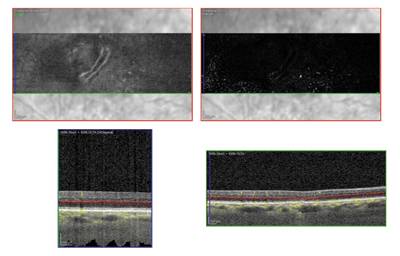Researchers find additional uses for OCT, ERG technologies

Research continues to reveal additional uses for evolving technology in the realm of OCT and ERG. These diagnostic tools offer eye care providers noninvasive means to determine signs and features of retinal impairment to better inform prognosis and treatment.
Details from a cross-sectional study published in Ophthalmology showed that patients with OCT images displaying a shallow, irregular retinal pigment epithelium elevation (SIRE) sign had a higher risk for nonexudative macular neovascularization (NE-MNV) and neovascular age-related macular degeneration.
“SIRE can be detected on the more ubiquitously available structural OCT B-scans and indicate eyes at higher risk of NE-MNV and, thus, subsequently neovascular AMD,” Callum Narita, BMedSc(Hons), from the Center for Eye Research Australia, Royal Victorian Eye and Ear Hospital in East Melbourne, and colleagues wrote. “These eyes could benefit from more frequent follow-up, and patients given more targeted advice regarding self-monitoring so that the likelihood of early detection of exudation before irreversible vision loss is increased.”

Source: Doug Rett, OD, FAAO
Narita and colleagues assessed a discovery cohort comprising four eyes. Patients in this cohort previously received a diagnosis of AMD with definitive NE-MNV as detected on swept-source OCT angiography (SS-OCTA) and the double-layer sign on spectral-domain OCT. The investigators also analyzed an evaluation cohort (233 eyes) comprising patients with AMD with large drusen (125 µm or more) in at least one eye.
Review of the discovery cohort showed that characteristics of the double-layer sign common in NE-MNV included a length of 1,000 mm or more, retinal pigment epithelium (RPE) elevation less than 100 mm, an irregular overlying RPE layer and a nonhomogenous reflectivity. Researchers termed all of these features as SIRE.
Features on OCT images from the evaluation cohort significantly associated with NE-MNV when RPE evaluation was more than 1,000 µm included height of RPE elevation, overall flat or variable morphologic features, irregular RPE layer and nonhomogeneous reflectivity (all P = .032).
Researchers identified 24 eyes (10.3%) with SIRE. Six eyes in the evaluation cohort had definite NE-MNV on SS-OCTA imaging, all graded positively for SIRE. Investigators identified the absence of SIRE in 209 of 227 eyes (92.1%) without NE-MNV.
“The findings of our analysis of the diagnostic and predictive performance of the combined graded features that were associated significantly with NE-MNV suggest that together these features will detect almost all cases of NE-MNV,” the researchers wrote.
Steven Ferrucci, OD, FAAO, chief of optometry and residency director at Sepulveda VA Ambulatory Care Center and Nursing Home and professor at Southern California College of Optometry/Marshall B. Ketchum University, commented on the study results.
“This article attempts to determine some features of SD-OCT, described as the ‘double layer sign’ that would indicate subclinical, nonexudative choroidal neovascular membranes in asymptomatic eyes,” Ferrucci told Primary Care Optometry News. “The concept is important, as anything a clinician can find on OCT that may make a patient more likely to convert from dry to wet or exudative AMD is crucial. That way, we could follow these patients at higher risk more frequently, to refer for treatment at the first sign of conversion to wet AMD. It is also important that these findings can be seen on SD-OCT and not only on swept source or OCT angiography, as many clinicians do not have these more expensive options.”

Source: Doug Rett, OD, FAAO
Ferrucci noted that the shortcomings of SD-OCT include that the OCT findings described in the study can be subtle at times, so practitioners must be astute to use this information.
“Further, the OCT used was a Heidelberg, so it is unclear if these findings would relate to other brands of OCTs, although it seems likely that it would, as long at the resolution is sufficient,” he said. “Also, as the authors point out, the sample size was relatively small, and the patients were not followed longitudinally, neither of which I feel outweigh the significance of this study.”
What is outer retinal tubulation?
In an ongoing discussion of new nomenclature and discoveries in OCT, Doug Rett, OD, FAAO, from the VA Boston Healthcare System, focused attention toward outer retinal tubulations (ORTs), which are “void hyporeflective spaces with hyperreflective borders on conventional B-scan OCT,” he said.
“In 2009, Dr. Sandrine Zweifel and her team in New York coined this term as the title of a paper they published describing the lesions,” Rett wrote in his Healio blog.
“On a cross-sectional OCT, we see them as circles (doughnuts), but an en face OCT reveals them as tubes, some straight and some with large, branching networks,” he continued. “They’re found in multiple retinal degenerative conditions, but the most common is AMD and usually severe cases when the RPE is compromised. The pathogenesis of ORT is murky, but these tubes seem to form when photoreceptors lose interdigitation of the RPE.”
Zweifel and colleagues postulated that after the photoreceptors detach from the RPE, there is a disruption of tight junctions in adjacent photoreceptors, leading to an “outward folding of the photoreceptor layer until opposite sides of this fold establish contact and form new lateral connections through tight junctions,” they said.

Source: Robert Dunphy, OD, FAAO
“The damaged photoreceptors start rolling up in a tube to protect themselves,” Rett explained. “ORTs typically occur in areas of normal retinal thickness (not areas that are completely atrophic retina), so perhaps they are a misguided attempt at repair. But what are they made of? What makes it hyporeflective on the inside but hyperreflective on the outside? What’s on the inside of the tube?”
Rett then discussed a study by Schaal and colleagues published in 2015 that detailed histological examination of 40 eyes from 40 donors with neovascular AMD, preserved less than 4 hours after their death. The researchers described it as “the largest number of advanced AMD eyes examined by histology to date specifically for photoreceptor degeneration.”
On the inside of the ORT, the group found cone bodies in varying states of degeneration, mostly without their outer segments. On the outside of the ORT, they found mostly external limiting membrane, with some translocated mitochondria from the inner segments of cones. This accounts for the hyperreflective ORT shell, as the mitochondria in the ellipsoid zone (of a healthy retina) are reflective on OCT.
The ORT literature also mentions how important it is to differentiate ORTs from intraretinal cysts or subretinal fluid (SRF), Rett said. Both cysts and SRF could be the sign of active exudative AMD, and if an ORT is mistaken for either one, the patient could be unnecessarily treated with anti-VEGF injections.
“So be diligent when checking for ORTs: Look for the hyperreflective shell of the ORT, which would not be present in cystoid macular edema (CME) cysts or SRF, and look at the location of the lesion; ORTs are considered to be always in the outer nuclear layer (ONL), whereas SRF and CME cysts are below and above the ONL, respectively,” Rett wrote. “Anti-VEGF therapy has not been shown to have any effect on ORTs, which makes sense now that we know it’s a general destructive sign rather than a sign of active exudative disease (Filho et al.).”
ERG can detect retinal ischemia
ERG is a relatively new technology that aids in the management and treatment of retinal neovascularization by providing objective details.
Ashley Allee, OD, an ocular disease resident at Fromer Eye Centers, presented a poster at the American Academy of Optometry meeting on the differential diagnoses of retinal neovascularization and the use of ERG to treat and manage proliferative diabetic cases. Allee spoke with PCON at a New Jersey Academy of Optometry continuing education meeting about her poster.
She discussed a case of a 22-year-old black woman with type 1 diabetes for approximately 10 years who had been experiencing blurred vision for between 1 month and 2 months. After the exam, the patient received three bevacizumab intravitreal injections in the right eye, one bevacizumab intravitreal injection in the left eye and panretinal photocoagulation in both eyes.
Six months after treatment, ERG showed relatively stable right eye with resolved macular edema and persistent retinal neovascularization on fluorescein angiography as well as recurrent vitreous hemorrhage. ERG of the left eye showed reduced phase value indicating ongoing ischemia, although fluorescein angiography showed no vascular leakage. ERG results after further monitoring without treatment indicated that anti-VEGF treatment in the left eye will prevent further progression.
“Though my research, I had different cases, and I showed that ischemic changes can be found on the ERG before retinopathy is even present,” Allee told PCON.
In the proliferative cases, Allee explained that ERG was performed prior to, during and after treatment. This can clarify if treatment is helping the retinal neovascularization and ischemia or if the patient needs further treatment. Additionally, she used fluorescein angiographies to compare structure and function with the ERG.
“Some take-home points that are very important are that the ERG can detect this retinal ischemia and can be a very useful diagnostic tool that can unveil the retinal function changes that may not be present on funduscopy,” she said. “This can be very important when treating proliferative diabetic cases.” – by Talitha Bennett and Erin T. Welsh
References:
Allee A. Differential diagnoses of retinal neovascularization and using electroretinography to aid with management and treatment. Presented at: American Academy of Optometry meeting; Orlando, Fla.; October 22-27, 2019.
Filho RGG, et al. Int J Retin Vitr. 2016;doi:10.1186/s40642-106-0029-8.
Litts KM, et al. JAMA Ophthalmol. 2015;doi:10.1001/jamaophthalmol.2015.126.
Schaal KB, et al. Retina. 2015;doi:10.1097/IAE.0000000000000471.
Zweifel SA, et al. Arch Ophthalmol. 2009;doi:10.1001/archophthalmol.2009.326.
For more information:
Steven Ferrucci, OD, FAAO, is chief of optometry and residency director at Sepulveda VA Ambulatory Care Center and Nursing Home, and a professor at Southern California College of Optometry/Marshall B. Ketchum University.
Callum Narita, BMedSc(Hons), is from the Centre for Eye Research Australia, Royal Victorian Eye and Ear Hospital, East Melbourne, Australia.
Doug Rett, OD, FAAO, sees patients and works with students and residents at the optometry clinic for the VA Boston Healthcare System. He can be reached at: doctorrett@gmail.com.
Disclosures: Ferrucci reports he has served on the speakers panel or advisory board for Alcon, Bausch + Lomb, Centervue, Genentech, Maculogix, Regeneron, Optovue and ScienceBased Health. Allee, Narita and Rett report no relevant financial disclosures.
